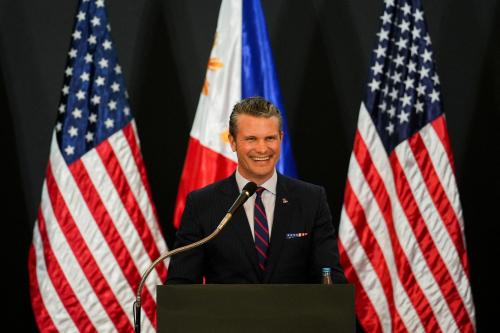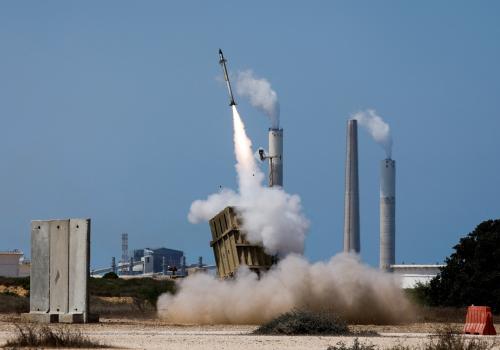At the Nonproliferation Treaty Review Conference later this month at the United Nations, the five nuclear weapon states recognized by the Treaty—the United States, Russia, Britain, France, and China—will come in for critical scrutiny from an international community that regards current approaches to nuclear arms as inadequate.
Just take Moscow’s aggression toward Ukraine, which has introduced dramatic new tensions into relations between the West and Russia. The crisis should also remind us, however, of the dangers posed by nuclear weapons and of our common interest in reducing and eliminating that threat.
It has been six years since President Obama’s April 2009 speech in Prague, where he embraced the vision of a world free of nuclear weapons. Since then the world has taken important steps toward realizing that vision:
• The New START Treaty, which entered into force in February 2011, is reducing the levels of strategic nuclear forces deployed by the United States and Russia.
• Nuclear security summits held in Washington DC in 2010, in Seoul in 2012, and in The Hague in 2014 have promoted a broad international consensus on the need to take action to secure nuclear materials.
• The P5+1 negotiation with Iran appears headed for an agreement that addresses international concerns about Tehran’s nuclear program.
These are important steps. We should build on them. But the broader nuclear reductions process has stalled.
The Comprehensive Test Ban Treaty has not yet entered into force. There is no agreement on new U.S.-Russian nuclear reductions negotiations, even though these two countries possess over 90 percent of the world’s nuclear warheads. And dangerous confrontations persist in the Middle East, South Asia, and Northeast Asia, some in which nuclear weapons programs mix with underlying rivalries and tensions.
We cannot be satisfied with the present state of affairs. It is imperative that the United States, key allies, Russia, China, and other states reinvigorate the nuclear reductions process and rekindle the vision of a world without nuclear weapons.
Some will say this is not the right time, given international tensions such as those between the West and Russia. We believe it is precisely the time. To be sure, it will not prove easy. But experience during the Cold War showed that cooperation is possible where areas of mutual interest are involved. Reinvigorating the nuclear reduction process would reinforce efforts to prevent the acquisition of nuclear weapons by additional states and terrorist groups and, in particular, build pressure on Iran to abide by agreements reached with the P5+1.
The nuclear security summit planned for 2016 offers an opportunity. It should include a day devoted to the establishment of a “Joint Enterprise” that would bring together a coalition of governments with serious nuclear credentials from around the world. The purpose: to approve the goal of creating the conditions for a world without nuclear weapons and develop a long-term work plan toward that end.
States taking part in the Joint Enterprise could bring to the 2016 summit specific commitments to take immediate actions. These could include, for example, a freeze on nuclear weapons stockpiles or declarations of national fissile materials holdings in accordance with an agreed standard format.
The long-term work plan would include steps to freeze and reduce nuclear weapons stockpiles and remove remaining weapons from prompt launch status; develop a highly effective worldwide verification system; and establish regional systems to facilitate conditions to enable the elimination of nuclear weapons. Reductions in U.S. and Russian stockpiles of deployed and non-deployed strategic and non-strategic nuclear warheads by fifty percent below current levels could be an early step.
Unfortunately, Russia has said that it will not participate in the preparatory process for the 2016 nuclear security summit. But fifty-three other nations are, and Moscow has time to change its mind.
Resolving or mitigating key territorial and other inter-state disputes that motivate states to acquire and maintain nuclear weapons must be a high priority. At the least, it is important to gain acceptance by the contending states that nuclear arms will not help them resolve their disputes—just as nuclear weapons have not helped resolve the Ukraine crisis. Global agreements will have to be supplemented by agreements that take into account specific regional conditions. All this will take time, an argument for starting sooner rather than later.
A Joint Enterprise would launch a multifaceted movement proceeding over many years or decades in different forums. It would be nothing less than an effort to construct a safer global security environment. It could fit into a broader effort to build institutions to succeed those created after World War II, which built the foundations for peace, freedom, and prosperity in that era, but which are proving inadequate for meeting 21st century challenges.
So the agreement of a coalition of the willing to a set of priorities for action to create the conditions for a world without nuclear weapons would provide just the beginning of a very complex undertaking. But we need a beginning and a sense of urgency.
Time is short to prepare for a meeting of the coalition of the willing in 2016. President Obama should launch such a coalition effort to move toward realizing his Prague vision.
This piece originally appeared in Fox News.
The Brookings Institution is committed to quality, independence, and impact.
We are supported by a diverse array of funders. In line with our values and policies, each Brookings publication represents the sole views of its author(s).


Commentary
Op-edNuclear non-proliferation: We must keep working for a world without nuclear weapons (yes, it’s possible)
April 24, 2015